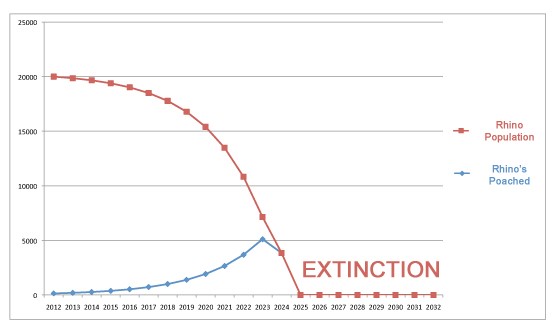Poaching - The Real menace for the Rhinos
Posted on September 22nd, 2020

At the beginning of the 20th century, 500,000 rhinos roamed Africa and Asia. By 1970, rhino numbers dropped to 70,000, and today, around 27,000 rhinos remain in the wild.
Very few rhinos survive outside national parks and reserves due to persistent poaching and habitat loss over many decades. Of the five rhino species living in Africa and Asia, three are listed by the IUCN as Critically Endangered: Javan Rhinos, Sumatran rhinos and black rhinos. Meanwhile, White rhinos are considered near threatened, and greater one-horned rhinos vulnerable to extinctions.
The rhino crisis impacts South Africa most heavily because it’s where 80% of the world rhino population is found making it a global issue.
In the last decade, 8,889 rhinos have been poached in Africa and the figure is rising at a rate of 2.5 deaths per day.

Why are Rhinos so easy targets for poachers?
Rhinos have very poor eyesight and they cannot see stationery objects even just a few meters away from them.
Their poor eyesight leaves them very vulnerable against experienced poachers who are able to approach them within a few meters before opening fire.

How does the poaching syndicate work?
At the lower end of the spectrum of poachers you find subsistence poachers.
They are usually from poor communities are driven by poverty and hunger. Subsistence poachers are usually on foot and will shoot the rhino with random fire to the head and chest area, as well as the legs in order to immobilize the animal.
They will then remove the horns very roughly using an axe. These poachers take high risk for comparatively little reward.
They will usually pass the horns to a syndicate member after the job is done.
At the higher end of the spectrum you will find professional poachers. They have well-structured operations and use high technology methods which involve –
- Tranquillizer guns
- Helicopters
- Veterinary Drugs
- High calibre weapons
Poaching Professionals
Many of the poachers seem to have had military training. They will normally have prior access to information about the farm they intend to target. These professional poachers are driven by a desire for financial gain and sheer greed.
The fact that highly controlled and regulated veterinary drugs are used in certain cases of rhino poaching indicates the involvement of professional veterinarians.
When they land the helicopter, they hack the horns with a chainsaw. This will take less than seven minutes to bring down the animal.
The use of a helicopter allows for easy access and quick getaways.
The rhino subsequently dies either from an overdose of tranquillizers or bleeds to death.
.jpeg)
Wildlife Industry insiders part of the problem?
Increasing evidence links South Africa rhino poaching with wildlife industry insiders. These individuals are obviously in a great position to run wildlife crime syndicates and are typically also well-funded and connected within the industry.
Thus, they obviously have access to guns, permits, vehicles and charter aircraft making rhino poaching much easier for these syndicates.
These rumours seem to have merit because of the increasing number of arrests of –
- Game ranchers
- Safari operators
- Professional hunters
As threats to species and natural resources escalate worldwide, conservation is looking more and more like war. National militaries play a role in conservation in the Congo, Cameroon, Guatemala, Nepal, and Indonesia. British troops have been sent to Malawi to provide ranger training. The U.S.-based non-profit Veterans Empowered to Protect African Wildlife (VETPAW) sends veterans to “lead the war” against wildlife crime in Africa.
The rhino conservation war is a human war between the conservationists and the poachers.
The crisis continues, the job of protecting rhinos has changed dramatically. Surveillance technology like drones and light aircraft are used to spot signs of trouble. Rangers are trained by ex-military specialists. Species are swiftly being wiped out by the illegal wildlife trade, and the urgency of the situation provokes a panicked, violent response among those fighting to keep these species alive. But many conservationists are concerned about what the militarization of conservation means—for people, and for the success of conservation itself.
For rangers and other conservationists, the reserves themselves can become places of horror. Apart from the personal danger they face, they witness nearly constant violence toward the animals they love. It's a frustration for the rangers.
For the rangers the rhino war, it’s just like drugs. It involves lots of cash, bribe and lives.


